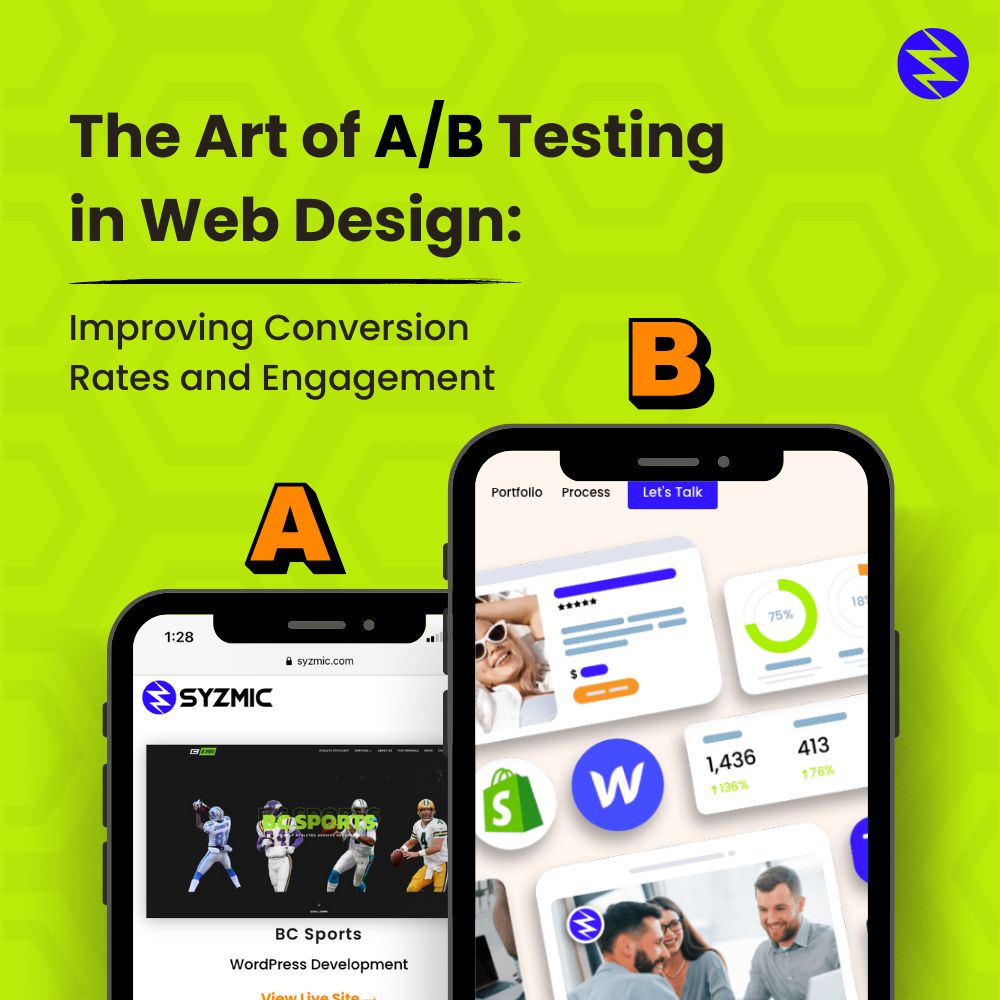In today’s competitive digital landscape, creating a visually stunning website is not enough to ensure success. It is equally important to optimize the website’s performance and user experience to drive conversions and engagement. One of the most powerful tools in a marketer’s arsenal is A/B testing, also known as split testing. A/B testing allows web designers and marketers to experiment with different design elements and content variations to identify the most effective combinations that lead to improved conversion rates and higher user engagement. In this blog, we will explore the art of A/B testing in web design and discuss how it can be leveraged to enhance the performance of your website.
Section 1: Understanding A/B Testing
A/B testing is a method of comparing two or more versions of a web page to determine which one performs better. The process involves dividing website traffic into different groups and presenting each group with a different version of the same page. Key metrics are then measured to evaluate which variation drives higher conversions, click-through rates, or other desired outcomes.
The beauty of A/B testing lies in its ability to provide empirical data and insights, rather than relying on assumptions or gut feelings. It allows marketing managers and web designers to make data-driven decisions, which leads to continuous improvement and better user experiences.
Section 2: Elements to Test in A/B Testing
- Call-to-Action (CTA) Buttons: Experimenting with different CTA button colors, text, size, and placement can significantly impact user behavior and conversions. A well-crafted CTA can guide users toward desired actions, such as signing up for a newsletter, making a purchase, or downloading a resource.
- Headlines and Copy: A/B testing different headlines and copy variations can reveal which messaging resonates best with the target audience. It is essential to test not only the content but also the tone and language used to communicate with visitors.
- Visuals and Media: Testing different images, videos, and graphics can determine the most compelling visual content that encourages users to stay on the website and engage further.
- Layout and Navigation: Evaluating different website layouts and navigation structures helps determine the most intuitive design that leads to improved user experience and reduced bounce rates.
- Forms and Checkout Processes: Optimizing form fields and the checkout process can reduce friction and improve completion rates for lead generation or sales.


Section 3: Setting Up a Successful A/B Test
To ensure meaningful results from A/B testing, it’s crucial to follow a systematic approach:
- Define Clear Objectives: Determine the specific goals of the test. Whether it’s increasing sign-ups, purchases, or time on page, having clear objectives will guide the testing process.
- Choose the Right Tools: Several A/B testing tools are available, such as Google Optimize, Optimizely, and VWO. Select a tool that aligns with your requirements and integrates seamlessly with your website.
- Create Variations Based on Hypotheses: Develop variations of the web page based on well-formed hypotheses. For example, if you believe a red CTA button will perform better than a green one, design both versions and test them.
- Randomize and Segment Traffic: Randomly assign website visitors to different variations to avoid bias in the results. Also, segmenting traffic based on user characteristics can provide valuable insights into audience preferences.
- Run Tests Simultaneously: Ensure that the A/B tests run concurrently, and for a sufficient duration to gather statistically significant data. Avoid running tests during unusual traffic spikes or marketing campaigns that could influence results.
- Analyze and Draw Conclusions: Analyze the results to determine which variation performed better. Remember to consider factors such as statistical significance and confidence levels before drawing conclusions.
Section 4: Leveraging A/B Test Results for Continuous Improvement
The true value of A/B testing lies in the insights gained from the results. After identifying the winning variation, implement the changes permanently on the website. However, the process doesn’t end there. The art of A/B testing involves continuous improvement through iterative testing and refinement.
- Implementing Successful Changes: Apply the winning variation across the website to benefit from the improved performance. Monitor the impact of these changes to validate the effectiveness of the A/B test.
- Iterative Testing: Don’t rest on your laurels. Web design is an ongoing process, and user preferences may change over time. Continue A/B testing different elements to further optimize your website’s performance.
- Multivariate Testing: As your expertise in A/B testing grows, consider adopting multivariate testing, which allows you to test multiple elements simultaneously. This advanced approach can reveal complex interactions between design elements and provide deeper insights.
- Monitoring User Feedback: A/B testing may not always capture qualitative aspects of user experience. Collecting user feedback through surveys, heatmaps, and usability tests can complement A/B test results and uncover additional improvement opportunities.
Section 5: Common A/B Testing Pitfalls and How to Avoid Them
While A/B testing can be a powerful tool, there are common pitfalls that marketers and web designers should be aware of:
- Testing Too Many Variations: Overloading an A/B test with too many variations can lead to inconclusive results and difficulties in pinpointing the most effective changes.
- Ignoring Statistical Significance: Relying on results without considering statistical significance can lead to erroneous conclusions and poor decision-making.
- Disregarding Mobile Users: With the increasing dominance of mobile devices, it’s essential to test variations on both desktop and mobile platforms.
- Neglecting Long-Term Impact: Some changes that lead to immediate improvements may not necessarily be sustainable in the long run. Always consider the long-term impact of the changes implemented.
Conclusion
A/B testing is a fundamental aspect of web design and digital marketing. By experimenting with different design elements and content variations, marketing managers, marketing directors, and CMOs can unlock powerful insights that drive higher conversion rates and engagement on their websites. The art of A/B testing lies in the continuous pursuit of improvement, leveraging data-driven decisions, and ultimately providing users with an exceptional online experience. By making A/B testing an integral part of your web design strategy, you can stay ahead of the competition and deliver remarkable results in the pursuit of growth and improvement.








0 Comments